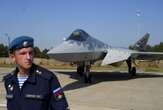A strange helicopter has been making test flights in the south of France. Built by French company Airbus Helicopters, it looks a bit like what would happen if a regular helicopter and an airplane merged into a single aircraft. It’s called Racer, and its goal is to go faster than a regular helicopter can.
Racer took to the sky for the first time on April 25, and it has since made multiple test flights. During the fifth flight, on June 3, which lasted two hours, Racer hit a speed of 190 knots (219 mph), according to Tomasz Krysinski, director of research innovation for Airbus Helicopters. That’s fast—cruise speed for helicopters is usually in the 150 knot range (173 mph). The goal is for Racer to eventually cruise at 220 knots (253 mph).
“Humans always want to do things faster,” Krysinski says, noting that the vehicle also has practical applications: Airbus Helicopters sees both civil and military uses for this design, including responding quickly and deftly to medical emergencies.
Here’s how Racer’s design allows it to travel faster than a regular helicopter—and how other odd-looking experimental models have fared with their speedy goals.
Helicopter meets airplane
Unlike most helicopters, which feature an enormous rotor on the top and a small one at the back, Racer lacks a traditional tail rotor but sports those two wing-attached propellers. Krysinski says that each measures more than 8 feet in diameter.
Racer’s most noticeable feature is that it has wings, with large propellers on them, one on each side.
Situating these powerful propellers at the tips of biplane-like wings helps Airbus address a speed-limiting factor that’s baked into the way a regular helicopter works. With most helicopters, when they try to go fast, the top rotor blades spin rapidly, encountering significant drag, as well as another aerodynamic issue called retreating blade stall.
Mike Hirschberg, director of strategy at the nonprofit Vertical Flight Society, says that a “general barrier” for traditional helicopter speed has been around 200 knots (230 mph), something helicopter makers have tried for years to break through inventive design. Sikorsky, for example, created a model that uses two top rotor blades stacked on top of each other, with each one spinning in a different direction. Airbus’s approach, with its wings and propeller combination, appears to be a bit simpler.
When the Airbus helicopter is flying forward, its wings give the aircraft lift, just like wings on an airplane do, and the propellers push it forward. That means that the top rotor is responsible for doing a bit less work. “At 220 knots, half of the lift comes from the rotor, and half from the wing,” Krysinski says. Because the rotor is doing less work, it can spin more slowly, avoiding some of the aerodynamic issues that helicopters experience at fast speeds.
The propellers on the wings provide a secondary benefit, beyond pushing the helicopter forward to help it hit high speeds: They help out when the helicopter is hovering. That tail rotor at the back of a conventional helicopter provides what’s known as an anti-torque system: Without that tail rotor, the helicopter would spin around in circles in response to the main rotor’s motion.
But Racer doesn’t have a traditional tail rotor. Airbus decided that it could keep things simplified by using the propellers to do the anti-torque job. Each propeller can send its thrust either forward or backward, mitigating the forces of the big spinning top rotor.
And Racer has yet another trick up its aluminum- and carbon-fiber sleeve. When it’s cruising forward in a specific speed range—between 180 and 190 knots—the pilots can shut off one of the engines, saving fuel. “We call it eco-mode,” Krysinski says. Pilots can start the engine back up again as needed.
The need for speed
The winged Racer is certainly not the first helicopter designed to go faster. Hirschberg, of the Vertical Flight Society, says that for approximately 70 years, aircraft makers have tried to create “a better helicopter—something that can take off and land vertically, but go faster than a conventional helicopter.”
One such attempt was a military aircraft, the AH-56 Cheyenne, a helicopter with a weirdly elongated appearance dating to the late 1960s that also had wings as well as a propeller (and a tail rotor) in the back. It crashed in 1969, and the test pilot died. In 1972, the Cheyenne program was canceled.
More recently, a sleek-looking creation from Connecticut-based Sikorsky called the X2 was able to hit an impressive 250 knots in 2010. That aircraft, which is now part of the National Air and Space Museum, used those two counterrotating top rotors and a single rear propeller to overcome the speed limitations traditional helicopters face.
Modern military competitions have propelled helicopter design forward as well, producing advanced flying machines that look different from a standard whirlybird. A U.S. Army competition called the Future Attack Reconnaissance Aircraft program heated up in 2020 when the Army winnowed down the players to just the Fort Worth, Texas-based company Bell Textron, and Sikorsky, which is a part of defense giant Lockheed Martin. Bell’s offering was the 360 Invictus and had short wings to help give it lift. Sikorsky’s was called the Raider X and looked a bit like its X2 aircraft. But the Army canceled that competition in February, citing in part lessons learned from the war in Ukraine about future aviation needs.
Sikorsky and Boeing joined forces for a different Army competition to create a helicopter that was even bigger than Raider X, but in 2022 the team lost out to an offering from Bell called the V-280 Valor, a “tilt-rotor aircraft”—another type of plane-helicopter hybrid—that the Army plans to use for the kind of logistical tasks it’s been using Black Hawk helicopters for, such as ferrying troops or equipment from place to place. Despite these domestic setbacks, Sikorsky’s Luigi Piantadosi, director of their Future Vertical Lift International division, says its X2 tech has attracted “significant international interest.”
U.S. military helicopter development has had to endure the turbulence of changing Department of Defense policy, but over in Europe, Racer flies onward. In fact, half of Racer’s funding came from a European program called Clean Sky 2, which has an environmental focus. Perhaps someday this unique whirlybird, with its wings and propellers, will prove useful as a flying machine capable of cruising faster than a regular helicopter, offering a way for the military or for civilian customers to carry out time-sensitive missions.










No comments